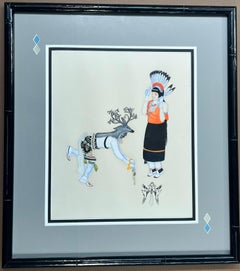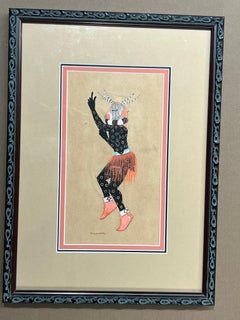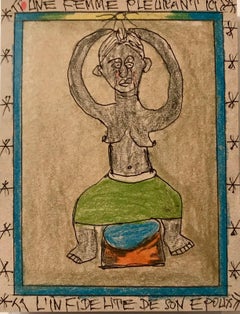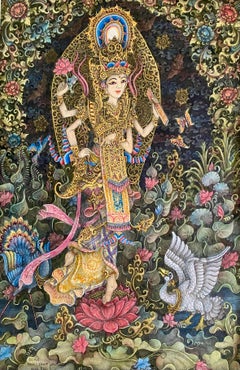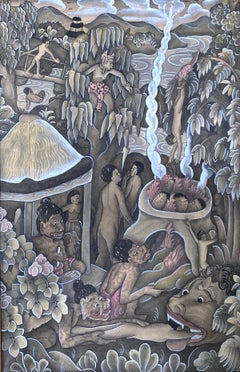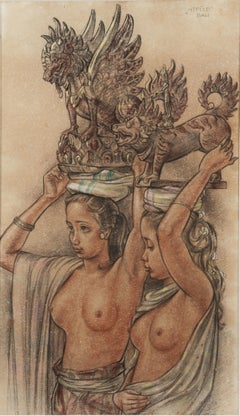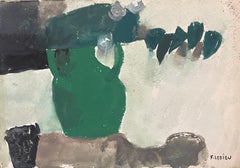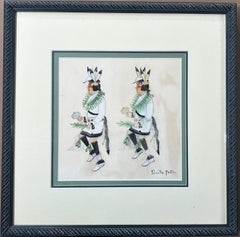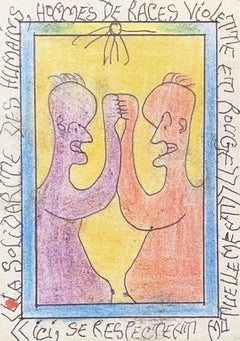Tribal Figurative Drawings and Watercolors
to
2
4
4
2
6
5
1
Overall Height
to
Overall Width
to
4,536
3,270
581
344
276
223
217
213
160
156
58
55
54
47
6
4
3
3
2
2
2
2
1
1
1
1
1
4
2
2
1
1
4
4
3
2
2
Style: Tribal
Deer Dance, painting by Tonita Pena, Santa Fe, Cochiti, Pueblo, male, female
Located in Santa Fe, NM
Deer Dance, painting by Tonita Pena, Santa Fe, Cochiti, Pueblo, male, female
Tonita Peña (born 1893 in San Ildefonso, died 1949 in Kewa Pueblo, New Mexico) was born as Quah Ah (meaning white coral beads) but also used the name Tonita Vigil Peña and María Antonia Tonita Peña. Peña was a renowned Pueblo artist, specializing in pen and ink on paper embellished with watercolor. She was a well-known and influential Native American artist and art teacher of the early 1920s and 1930s.
Tonita Peña was born on May 10, 1893, at San Ildefonso Pueblo, to Ascensión Vigil Peña and Natividad Peña of San Ildefonso Pueblo, New Mexico. When she was 12, her mother and younger sister died, as a result of complications due to the flu. Her father was unable to care for her and she was taken to Cochití Pueblo and was brought up by her aunt Martina Vigil Montoya, a prominent Cochití Pueblo potter. Peña attended St. Catherine Indian School in Santa Fe.
Edgar Lee Hewett, an anthropologist involved in supervising the nearby Frijoles Canyon excavations (now Bandelier National Monument) was instrumental in developing the careers of several San Ildefonso “self-taught” artists including Tonita Peña. Hewett purchased Peña's paintings for the Museum of New Mexico and supplied her with quality paint and paper. Peña began gaining more notoriety by the end of the 1910s selling an increasing amount of her work to collectors and the La Fonda Hotel. Much of this early work was done of Pueblo cultural subject matter, in a style inspired by historic Native American works, however, her use of an artist's easel and Western painting mediums gained her acceptance among her European-American contemporaries in the art world. At the age of 25, she exhibited her work at museums and galleries in the Santa Fe and Albuquerque area.
In the early 1920s, Tonita did not know how much her painting sold for at the Museum of New Mexico, so she wrote letters to the administrators because a local farmer was worried that she got paid too little.
In the 1930s Peña was an instructor at the Santa Fe Indian School and at the Albuquerque Indian School and the only woman painter of the San Ildefonso Self-Taught Group, which included such noted artists as Alfonso Roybal, Julian Martinez, Abel Sánchez (Oqwa Pi), Crecencio Martinez, and Encarnación Peña. As children, these artists attended San Ildefonso day school which was part of the institution of the Dawes Act of 1887, designed to indoctrinate and assimilate Native American children into mainstream American society.
In 1931, Tonita Peña exhibited at the Exposition of Indian Tribal Arts which was presented at the Grand Central Art Galleries in New York City. Works from this exhibition were shown at the 1932 Venice Biennial. That year is the only time Native American artists have shown in the official United States pavilion at that biennial, and Tonita Peña's paintings were part of that exhibition.[1 Her painting Basket Dance, that had shown in the Venice Biennial was acquired by the Whitney Museum of American Art in New York for $225. This was the highest price paid up to this time for a Pueblo painting...
Category
1940s Tribal Figurative Drawings and Watercolors
Materials
Paint, Paper
Corn Kachina, by Riley Sunrise, Quoyavema, Hopi, Kachina, Dancer, painting
Located in Santa Fe, NM
Corn Kachina, by Riley Sunrise, Quoyavema, Hopi, Kachina, Dancer, painting
Artist Signature - Riley Sunrise (1914-2006) Quoyavema “Another of the earlier Hopi artists, Riley Sunrise (Quoyavema) worked with Fred Kabotie and Waldo Mootzka in illustrating John Louw Nelson’s Rhythm for Rain. He is also known as Quoyavema or Kwayeshva, according to Nelson. His paintings are comparable to Fred Kabotie’s, with some of them showing more action and most of them revealing less detail. Sunrise is represented in the collections of the Denver Art Museum, Gilcrease Institute (Tulsa), and the Southwest Museum. The Museum of the American Indian in New York has an extensive collection of his paintings of native Hopi dances.” (Clara Lee Tanner: Southwest Indian...
Category
1940s Tribal Figurative Drawings and Watercolors
Materials
Paint, Paper
No title
Located in Tel Aviv - Jaffa, IL
Ballpoint Pens, Crayons And Colored Pencil On Cardboard
Unique piece
Hand signed and dated on the reverse
Category
Early 2000s Tribal Figurative Drawings and Watercolors
Materials
Cardboard, Ink, Pen, Color Pencil
No title
Located in Tel Aviv - Jaffa, IL
Ballpoint Pens, Crayons And Colored Pencil On Cardboard
Unique piece
Hand signed and dated on the reverse
Category
Early 2000s Tribal Figurative Drawings and Watercolors
Materials
Ink, Cardboard, Pen, Color Pencil
“Saraswati”
Located in Southampton, NY
Very finely executed ink and watercolor painting depicting the Balinese goddess, Saraswati. Signed lower left “De Mus, keliki-Kawan, Ubud, Bali”. The ...
Category
1970s Tribal Figurative Drawings and Watercolors
Materials
Ink, Watercolor, Archival Paper
“Untitled”
Located in Southampton, NY
Provocative watercolor, gouache on paper Balinese tribal artwork. Not signed. Circa 1950. Condition is very good. No issues. Finely painted and meticulously detailed artwork of a ta...
Category
1950s Tribal Figurative Drawings and Watercolors
Materials
Watercolor, Paper, Gouache
Related Items
Two Balinese Beauties (Mapeed), circa 1945
By Johan Rudolf Bonnet
Located in Amsterdam, NL
Rudolf Bonnet (1895-1978)
'Mepèèd' (Mapeed)
Signed lower right
Titled upper right
Pastel on gouache pigmented paper, 57 x 34 cm
In original carved ebo...
Category
1940s Tribal Figurative Drawings and Watercolors
Materials
Paper, Crayon, Pastel, Gouache, Pencil
Free Shipping
H 22.45 in W 13.39 in D 0.04 in
French Contemporary Art by Francine Ledieu - Untitled
Located in Paris, IDF
Gouache on paper
Francine Ledieu is a French artist born in 1931 who lives and works in Paris, France. In the 50s, she was a student of Maurice Rocher who specialized in Sacred art. In the ’80s, Francine was a student of Jean Bertholle from the Saint Roch Academy. The artist had personal exhibitions at Maison Mansart from 1989 to 1993 and at Étienne de Causans Gallery in 1997. In 1998 & 2009 she exhibited at La Petite Galerie. Francien Ledieu had three exhibitions at La Capitale Gallery in 2001, 2004, and 2007. She also showed her paintings at L’Oeil du Huit in 2011, 2013, 2016 & 2019. She participated in many group exhibitions as at Strasbourg Contemporary Art Fair in 2005. She exhibited also at Réalités Nouvelles...
Category
1960s Tribal Figurative Drawings and Watercolors
Materials
Gouache, Paper
H 6.7 in W 9.65 in D 0.04 in
Porsche. Figurative realistic acrylic on paper painting Polish art, Car
Located in Warsaw, PL
Acrylic on paper contemporary figurative painting by Michal Wojtysiak. Artwork depicts Porsche 993 Turbo car in realistic style. The color is vibrant and saturated. Michal Wojtysiak...
Category
2010s Tribal Figurative Drawings and Watercolors
Materials
Paper, Acrylic
French Contemporary Art by Francine Ledieu - Landscape
Located in Paris, IDF
Gouache on craft paper
Francine Ledieu is a French artist born in 1931 who lives and works in Paris, France. In the 50s, she was a student of Maurice Rocher who specialized in Sacred art. In the ’80s, Francine was a student of Jean Bertholle from the Saint Roch Academy. The artist had personal exhibitions at Maison Mansart from 1989 to 1993 and at Étienne de Causans Gallery in 1997. In 1998 & 2009 she exhibited at La Petite Galerie. Francien Ledieu had three exhibitions at La Capitale Gallery in 2001, 2004, and 2007. She also showed her paintings at L’Oeil du Huit in 2011, 2013, 2016 & 2019. She participated in many group exhibitions as at Strasbourg Contemporary Art Fair in 2005. She exhibited also at Réalités Nouvelles in 2006, 2007, 2010 & 2011. She also worked in stained glass and mosaics in France. She achieved artworks in 1963 at Saint-Henri Pontoise chapel, Saint-Pierre des Louvrais church in Pontoise in 1969 & Mosaic in the same year at Jean Moulin...
Category
1960s Tribal Figurative Drawings and Watercolors
Materials
Gouache, Paper
H 12.41 in W 9.45 in D 0.04 in
Mercedes 300 SLR Uhlenhaut coupe Figurative acrylic on paper painting Polish art
Located in Warsaw, PL
Acrylic on paper contemporary figurative painting by Michal Wojtysiak. Artwork depicts mercedes car in realistic style.
MICHAŁ WOJTYSIAK (ur. 1984)
Graduated of Academy of Fine Art...
Category
2010s Tribal Figurative Drawings and Watercolors
Materials
Paper, Acrylic
NYC Subway Mid 20th Century American Scene Social Realism WPA Modern 1930s
Located in New York, NY
NYC Subway Riders Mid 20th Century American Scene Social Realism WPA Modern 1930s
Daniel Celentano (1902 - 1980)
Subway Scene, 1930s
8 x 9 inches
Ink and wash on paper
Singed lower ...
Category
1930s Tribal Figurative Drawings and Watercolors
Materials
Paper, Ink, Gouache
Phil Richards
Located in London, GB
Charcoal and gouache on paper, titled ‘Phil Richards’ and dated ‘Friday Dec 8 72’ (lower left), 64cm x 48cm (72cm x 56cm framed).(Provenance: the Artist’s estate (stamped verso)). the picture is framed behind UV glass
Stonehouse had an extraordinary life. As a young art student studying fashion illustration, he joined the Royal Artillery at the beginning of WWII but soon became a part of the Special Operations Executive (SOE). He was sent to France as a radio operator but three and a half months later was caught by the Gestapo, tortured, given a death sentence and then selected for slave labour. He spent the subsequent war years in three French prisons and five concentration and labour camps, including Dachau. He still managed to continue to draw in some of the camps. Following the war, Stonehouse went to the US and continued his career as a fashion artist painting for magazines like Vogue, Harper's Bazaar and Elizabeth Arden. He was also an accomplished portraitist. His work is celebrated in Brian Stonehouse...
Category
1970s Tribal Figurative Drawings and Watercolors
Materials
Paper, Charcoal, Gouache
French Contemporary Art by Francine Ledieu - Landscape
Located in Paris, IDF
Gouache on paper
Francine Ledieu is a French artist born in 1931 who lives and works in Paris, France. In the 50s, she was a student of Maurice Rocher who specialized in Sacred art. In the ’80s, Francine was a student of Jean Bertholle from the Saint Roch Academy. The artist had personal exhibitions at Maison Mansart from 1989 to 1993 and at Étienne de Causans Gallery in 1997. In 1998 & 2009 she exhibited at La Petite Galerie. Francien Ledieu had three exhibitions at La Capitale Gallery in 2001, 2004, and 2007. She also showed her paintings at L’Oeil du Huit in 2011, 2013, 2016 & 2019. She participated in many group exhibitions as at Strasbourg Contemporary Art Fair in 2005. She exhibited also at Réalités Nouvelles in 2006, 2007, 2010 & 2011. She also worked in stained glass and mosaics in France. She achieved artworks in 1963 at Saint-Henri Pontoise chapel, Saint-Pierre des Louvrais church in Pontoise in 1969 & Mosaic in the same year at Jean Moulin...
Category
1960s Tribal Figurative Drawings and Watercolors
Materials
Gouache, Paper
H 13 in W 9.65 in D 0.04 in
Volkswagen K70. Contemporary figurative acrylic on paper car painting Polish art
Located in Warsaw, PL
Acrylic on paper contemporary figurative painting by Michal Wojtysiak. Artwork depicts volkswagen car in realistic style.
MICHAŁ WOJTYSIAK (ur. 1984)
Graduated of Academy of Fine A...
Category
21st Century and Contemporary Tribal Figurative Drawings and Watercolors
Materials
Acrylic, Paper
Nude - XXI Century, Contemporary Gouache and Charcoal Figurative Drawing, Female
By Marta Łebek
Located in Warsaw, PL
Marta Lebek is a Polish artist born in 1978. She currently lives and works in Spain.
She studied at the School of Fine Arts and specialized in the departm...
Category
21st Century and Contemporary Tribal Figurative Drawings and Watercolors
Materials
Paper, Charcoal, Gouache
Disappearances / Extinctions #1 Hélène Duclos 21st Century drawing landscape art
Located in Paris, FR
This drawing is part of the current exhibition entitled "The fantastic story of the liquid mountain" at Claire Corcia Gallery in Paris.
The liquid mountain is populated by living be...
Category
2010s Tribal Figurative Drawings and Watercolors
Materials
Color Pencil, Graphite, Paper, Gouache
H 39.38 in W 27.56 in D 1.97 in
Duchándome. Nude watercolor on paper
Located in Miami Beach, FL
Duchándome, by Celso Castro
From the Duchándome Series
Watercolor, ink, and pastel archival paper. NUDES 2D
Individual size: 19.5 in. H x 13.75 in. W
2018
Drawing on paper is his basic work tool, some are sketches of his surviving works, and others are sketches of moments he documents.
____________
Undefined by medium, Celso Castro’s works each carry the presence of the artist’s hand through the transparency of their process. Castro’s oeuvre is strongly divided between his photomontage assemblies and watercolor paintings: the prior is marked by the labor-intensive deconstruction of portrait photographs and the latter, by the seemingly frenzied recreation of a past encounter rendered in the drips and scribbles of paint and ink. Both discriminating in what they reveal of the subject, his photomontage and watercolor portraits exude raw sexuality through the combination of Castro’s mark-making and gaze. Celso Castro’s work is a bare-bulb erotic photo...
Category
2010s Tribal Figurative Drawings and Watercolors
Materials
Pastel, Archival Ink, Watercolor, Archival Paper
Previously Available Items
Pueblo Dancers, painting, by Tonita Pena, Cochiti, Pueblo, Santa Fe, Native Amer
Located in Santa Fe, NM
Pueblo Dancers, painting, by Tonita Pena, Cochiti, Pueblo, Santa Fe, Native Amer
Tonita Peña (born 1893 in San Ildefonso, died 1949 in Kewa Pueblo, New Mexico) was born as Quah Ah (meaning white coral beads) but also used the name Tonita Vigil Peña and María Antonia Tonita Peña. Peña was a renowned Pueblo artist, specializing in pen and ink on paper embellished with watercolor. She was a well-known and influential Native American artist and art teacher of the early 1920s and 1930s.
Tonita Peña was born on May 10, 1893, at San Ildefonso Pueblo, to Ascensión Vigil Peña and Natividad Peña of San Ildefonso Pueblo, New Mexico. When she was 12, her mother and younger sister died, as a result of complications due to the flu. Her father was unable to care for her and she was taken to Cochití Pueblo and was brought up by her aunt Martina Vigil Montoya, a prominent Cochití Pueblo potter. Peña attended St. Catherine Indian School in Santa Fe.
Edgar Lee Hewett, an anthropologist involved in supervising the nearby Frijoles Canyon excavations (now Bandelier National Monument) was instrumental in developing the careers of several San Ildefonso “self-taught” artists including Tonita Peña. Hewett purchased Peña's paintings for the Museum of New Mexico and supplied her with quality paint and paper. Peña began gaining more notoriety by the end of the 1910s selling an increasing amount of her work to collectors and the La Fonda Hotel. Much of this early work was done of Pueblo cultural subject matter, in a style inspired by historic Native American works, however, her use of an artist's easel and Western painting mediums gained her acceptance among her European-American contemporaries in the art world. At the age of 25, she exhibited her work at museums and galleries in the Santa Fe and Albuquerque area.
In the early 1920s, Tonita did not know how much her painting sold for at the Museum of New Mexico, so she wrote letters to the administrators because a local farmer was worried that she got paid too little.
In the 1930s Peña was an instructor at the Santa Fe Indian School and at the Albuquerque Indian School and the only woman painter of the San Ildefonso Self-Taught Group, which included such noted artists as Alfonso Roybal, Julian Martinez, Abel Sánchez (Oqwa Pi), Crecencio Martinez, and Encarnación Peña. As children, these artists attended San Ildefonso day school which was part of the institution of the Dawes Act of 1887, designed to indoctrinate and assimilate Native American children into mainstream American society.
In 1931, Tonita Peña exhibited at the Exposition of Indian Tribal Arts which was presented at the Grand Central Art Galleries in New York City. Works from this exhibition were shown at the 1932 Venice Biennial. That year is the only time Native American artists have shown in the official United States pavilion at that biennial, and Tonita Peña's paintings were part of that exhibition.[1 Her painting Basket Dance, that had shown in the Venice Biennial was acquired by the Whitney Museum of American Art in New York for $225. This was the highest price paid up to this time for a Pueblo painting...
Category
1940s Tribal Figurative Drawings and Watercolors
Materials
Paint, Paper
No title
Located in Tel Aviv - Jaffa, IL
Ballpoint Pens, Crayons And Colored Pencil On Cardboard
Unique piece
Hand signed and dated on the reverse
Category
Early 2000s Tribal Figurative Drawings and Watercolors
Materials
Color Pencil, Ink, Cardboard, Pen
African Village Painting by Aku unlo Original signed Mid Century Tribal Art
Located in FR
Vibrant Mid Century Tribal Art Painting by Aku unlo
Village Life
Paper stuck on card measuring 67cms by 26cms
Actual imagery measures 60cms by 16cms
Only very minor signs of age most...
Category
Mid-20th Century Tribal Figurative Drawings and Watercolors
Materials
Gouache
Free Shipping
H 10.24 in W 26.38 in
Untitled (Royal Portrait)
By Chris Ofili
Located in Toronto, Ontario
Chris Ofili's Royal Portraits are the most iconic and popular works from his fascinating oeuvre.
They highlight an important element in his work; the celebration of Afrocentric li...
Category
21st Century and Contemporary Tribal Figurative Drawings and Watercolors
Materials
Watercolor
Tribal figurative drawings and watercolors for sale on 1stDibs.
Find a wide variety of authentic Tribal figurative drawings and watercolors available for sale on 1stDibs. Works in this style were very popular during the 21st Century and Contemporary, but contemporary artists have continued to produce works inspired by this movement. Frequently made by artists working with Paint, and Paper and other materials, all of these pieces for sale are unique and have attracted attention over the years. Not every interior allows for large Tribal figurative drawings and watercolors, so small editions measuring 5.12 inches across are also available. Prices for figurative drawings and watercolors made by famous or emerging artists can differ depending on medium, time period and other attributes. On 1stDibs, the price for these items starts at $750 and tops out at $2,700, while the average work sells for $1,075.
